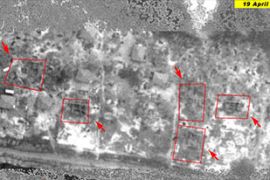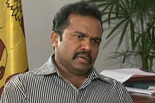Sri Lanka admits bombing safe zone
Leaked UN satellite images push government to admit raids but it says no civilians harmed.

The apparent admission follows the leaking of UN satellite images showing evidence of such attacks, supporting claims by Tamil groups that aircraft had bombed the area the government designated a safe zone in February.
President’s contradiction
But Mahinda Rajapaksa, Sri Lanka’s president, has contradicted Kohona by categorically denying that the military had attacked civilian areas with heavy weapons.
| In video | ||
|
|
“If you are not willing to accept the fact that we are not using heavy weapons, I really can’t help it,” he said.
“We are not using heavy weapons. When we say no, it means no. If we say we are doing something, we do it. We do exactly what we say, without confusion.”
The government had for weeks repeatedly denied that its armed forces were using heavy artillery or conducting air raids in the safe zone where it says the Liberation Tigers of Tamil Eelam (LTTE) have been holding civilians as human shields.
Many who have managed to get out say the fighters were indeed holding them against their will, and fired on them to prevent their escape.
Tens of thousands of civilians, along with members of the LTTE, are believed to still be in the 10sq km area.
On April 19, Kohona told Al Jazeera there was no government shelling in the safe zone.
| In depth |
|
|
“Absolutely not, because the government has issued instructions, very strict instructions, to the military not to use aerial bombing or shelling into this area.”
But on Friday, confronted by the latest UN satellite imaging agency (Unosat) pictures showing craters which were formed inside the zone between February and April this year, Kohona at first challenged their authenticity before admitting targeting the Tigers’ heavy guns.
He said, however, that it was before civilians flooded the area and maintained that the government adhered to international law.
Detailed images
Unosat says the pictures show craters which were formed inside the zone between February 15 and April 19, the day before the army breached the Tigers’ defences and civilians started to pour out.
Einer Bjorge, head of the mapping unit at Unosat, told Al Jazeera the pattern of the craters would have required air power.
| Focus: Sri Lanka | ||||||||||

|
“The imagery is fairly clear and shows the time, so anybody can study and compare them,” he said.
He said the images were also commercially available from the satellite operator.
“Anyone interested in verifying the images can purchase them if they want. It is commercially available to the public,” he said.
“You can’t get any more transparent than that.”
Meenakshi Ganguly, a senior researcher with Human Rights Watch (HRW), told Al Jazeera that the pictures did give evidence that civilians were at risk, saying the government may have “deliberately deceived the international community when they expressed concern about the situation”.
“The pictures do prove that heavy weapons were used and indeed civilian casualties did occur, as shown by UN figures of the death toll since January,” she said.
“In fact, HRW once recorded the sound of shelling which was dropping near a hospital.”
 |
| Many civilians who fled the war zone said Tamil Tiger fighters used them as shields [AFP] |
Yolanda Foster, an expert on Sri Lanka with Amnesty International, said “real fear” is growing for those trapped in the no-fire zone in light of the admission by Colombo that its forces had carried out raids.
“We are very concerned that this flagrant disregard for civilians living inside the ‘safe zone’ has now been admitted [by the Sri Lankan government],” she said.
“The government earlier on in the year was making claims that there were not so many civilians in the safe zone as, for example, the figures that the UN and Red Cross were giving out.
“It is not clear that the government can be trusted on its promises.”


